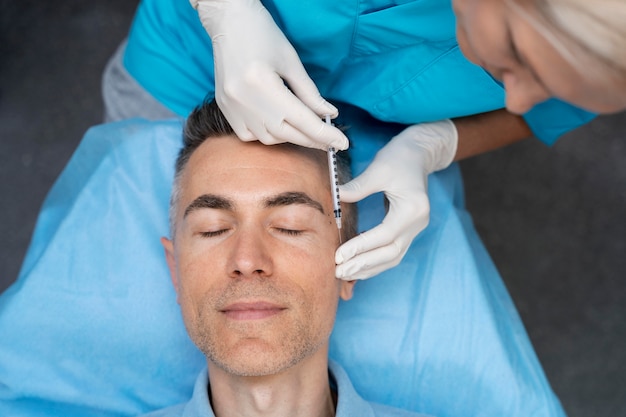Beards have transcended cultural boundaries, becoming a staple of style and self-expression for many men. For those facing challenges with beard growth, such as patchiness or thinning, a beard hair transplant presents an appealing solution. This guide will explore everything you need to know about Beard Hair Transplant in Dubai, from the fundamentals to the benefits and aftercare.
What is a Beard Hair Transplant?
A beard hair transplant is a cosmetic procedure that involves relocating hair follicles from one area of the body, often the scalp, to the beard region. This method is particularly popular among men who have inherited sparse facial hair or have experienced hair loss due to various reasons, including genetics or medical conditions. The end goal is to create a fuller, denser beard that enhances a person’s facial features and overall appearance.
Why Men Choose Beard Hair Transplants
There are numerous reasons why men opt for beard hair transplants. One of the primary motivations is genetics; many individuals find that they have inherited patchy or weak beard growth from their family. Additionally, hormonal imbalances can also affect hair development, leading to uneven or sparse facial hair.
For others, trauma, scarring, or medical issues may contribute to hair loss in the beard area. A beard hair transplant can serve as an effective remedy, not only restoring hair but also boosting self-confidence and enhancing one’s personal image.
Understanding the Procedure
Beard hair transplants can be performed using two primary techniques: Follicular Unit Extraction (FUE) and Follicular Unit Transplantation (FUT).
Follicular Unit Extraction is a minimally invasive technique that involves extracting individual hair follicles from a donor area, typically the scalp. Each follicle is carefully implanted into the desired areas of the beard. This method is favored for its ability to leave minimal scarring and promote quicker recovery times.
Follicular Unit Transplantation, in contrast, involves removing a strip of scalp from the donor site. The follicles are then extracted from this strip before being implanted in the beard area. While this technique may allow for more extensive grafting in a single session, it can result in more noticeable scarring.
Both procedures require a skilled professional to ensure that each follicle is placed strategically to mimic natural hair growth patterns.
Preparing for the Procedure
Before undergoing a beard hair transplant, it’s essential to have a thorough consultation with a qualified professional. During this initial visit, you will discuss your desired goals, expectations, and any medical history that may impact the surgery. The consultant may conduct a physical examination to determine the best approach tailored to your unique needs.
Preparation may also involve guidelines for how to care for your hair before the procedure. This can include avoiding certain medications or supplements that may increase bleeding or interfere with recovery.
Recovering After a Beard Hair Transplant
The recovery process following a beard hair transplant is generally smooth. Immediately after the procedure, there may be some swelling or redness in the transplant area. These symptoms are typically temporary and subside within a few days.
Following the aftercare instructions provided by the professional is vital to ensure optimal healing. Patients are often advised to avoid strenuous activities and direct sunlight during the initial healing phase. While initially, transplanted hair may shed, this is a normal part of the hair growth cycle. New hair should begin to emerge within a few months.
Caring for Your New Beard
Once the transplanted hair begins to grow, maintaining it becomes essential. Regular grooming, such as washing, trimming, and conditioning, helps keep the beard healthy and looking its best. Many men find that using beard oils and conditioners can nourish both the hair and the skin beneath, promoting better growth and a more polished appearance.
Additionally, finding the right products tailored to your hair type is crucial. Just as with scalp hair, different beard types may require different care routines.
Potential Risks and Complications
While beard hair transplants are generally safe, potential risks should be considered. Common issues can include infection, uneven growth, and patchy results if the procedure is not performed correctly. It’s important to select an experienced professional who can provide honest insights into the procedure and what results you can realistically expect.
The Psychological Benefits
The decision to undergo a beard hair transplant is often transformative, not solely from a physical standpoint but also psychologically. Many men experience a significant boost in self-esteem and confidence following the procedure. A fuller beard can enhance personal and professional interactions, big or small, allowing men to express their individuality without hesitation.
Long-Term Results and Maintenance
The longevity of results from a beard hair transplant largely depends on individual factors, including genetics and lifestyle habits. Regular grooming and care are fundamental to maintaining the appearance of your beard over time. Furthermore, being aware of any changes in hair density or growth can help identify potential issues early on.
Conclusion
A beard hair transplant offers a viable solution for achieving a fuller beard, providing numerous benefits that extend well beyond aesthetics. Understanding the procedure, recovery process, and maintenance requirements is crucial for anyone considering this option.
If you’re contemplating a beard hair transplant, take the time to research and consult professionals to ensure that your expectations are aligned with reality. With the right preparation and care, a beard hair transplant can truly be a life-changing experience, leading to greater confidence and a more defined sense of personal style.





Comments